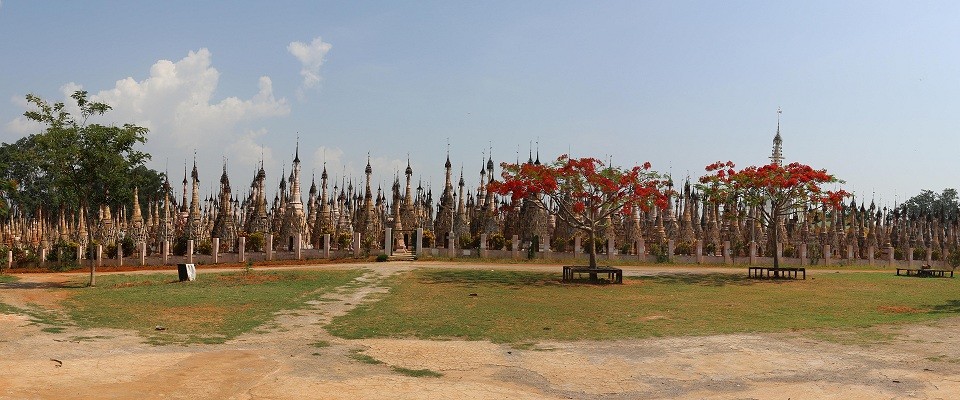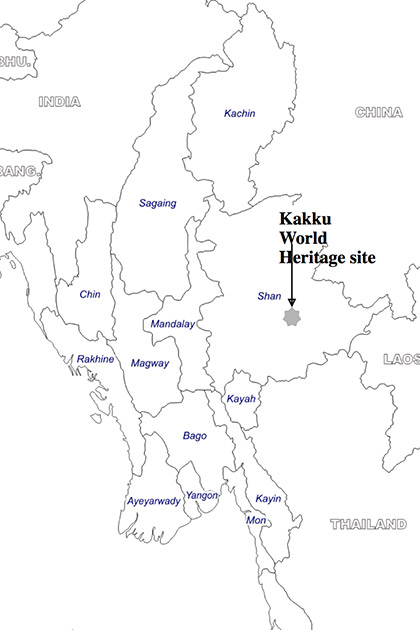"Qabel 1991 il-kumpless kien primarjament miżjur biss mill-Pa'oh u kien fil-biċċa l-kbira mgħotti mid-dinja akbar, sal-punt li anke f'Taunggyi il-popolazzjoni ġenerali ma kinitx konxja tal-post jew l-eżistenza tagħha" - Weraq tal-ġilju 2016.
Sit Deskrizzjoni
Kakku huwa sit naturali sagru notevoli, akkomodazzjoni mill-inqas 2478 pagodas u numru kbir ta 'siġar Bodhi sagru. Hija tinsab fl-istat Shan fil-Mjanmar, Xlokk tal-belt Taunggyi. Xi wħud jgħidu li hija mibnija bħala shrine għall-passaġġ tal-mejtin. Oħrajn isostnu li r-Re Alaung Sithu bena s-sit bħala punt ta’ mistrieħ għall-vjaġġaturi tax-xmara. Oħrajn għadhom jaraw il-post bħala li għandu proprjetajiet spiritwali sostanzjali, ibbażata fuq l-astroloġija tagħha. L-istejjer kollha jaqsmu r-rispett tagħhom għas-siġra Bohdi endemika sagra preżenti. Is-sit bħalissa qed jiffaċċja t-theddida li jinbidel ħafna mit-turiżmu, xi ħaġa li l-gvern jipprova jistimula. Biex itaffu dan il-proċess, il lokali ġisem mejjet kumitat joħloq modi biex jippromwovi l-kultura lokali u jqajjem kuxjenza dwar l-ispiritwalità tagħhom.
Theddid
Theddid għall-bijodiversità fir-reġjun jinkludu l-kaċċa u l-kaċċa, użu agrikolu tal-foresti naturali, bidliet fil-metodi ta’ kultivazzjoni, metodi tas-sajd distruttivi, introduzzjoni ta' speċi invażivi u infurzar dgħajjef tal-liġi kontra attivitajiet illegali bħall-kummerċ tal-annimali selvaġġi.
Sadanittant, inċentivi ekonomiċi bħall-pressjoni tal-iżvilupp u ż-żieda fit-turiżmu jmexxu lill-komunitajiet lokali lejn konċessjonijiet. Eżempji f'Kakku huma l-istabbiliment riċenti ta 'toroq b'saħħithom, il-konverżjoni tal-foresti f'art agrikola, żidiet fir-raħal u t-twaqqif ta’ parkeġġ u ristorant, li kollha ġew għall-ispiża tal-ħajja selvaġġa lokali. Skond l-arkeoloġi, il-pagodas huma mhedda minn materjali ta 'rikostruzzjoni ħżiena, li jagħmlu aktar ħsara fit-tul. Fir-rigward tal-kuntest kulturali, xi wħud jargumentaw li fir-rigward tas-sit ta’ Kakku bħala monument għall-preservazzjoni jimmina l-kapaċità tan-nies lokali li jgħaddu minn evoluzzjoni kulturali, u tneħħi l-kultura u l-identità lokali mis-sit.
Viżjoni
Hemm kunflitt intrinsiku ta’ viżjonijiet bejn is-sistema tal-Wirt Dinji u r-realtà ħajja tal-poplu Pa’oh, dwar il-mod kif iddokumentat is-sit ta’ Kakku. Ir-reġistrazzjoni u d-dokumentazzjoni fil-livell nazzjonali tal-valuri lokali huma suxxettibbli li jadottaw kunċetti globalizzati dwar l-ispiritwalità indiġena. Dan jankra l-valuri tal-komunitajiet indiġeni u jinjora l-evoluzzjoni, kunċetti dinamiċi tal-valuri lejn is-siti sagri tagħhom. Tqajjem mistoqsijiet dwar min għandu l-awtorità li jiddetermina t-tifsira ta 'sit naturali sagru, u jekk il-kategorizzazzjoni hija dejjem l-aħjar approċċ.
Azzjoni
Il-Pa'oh ġisem mejjet Ġestjoni ta' Eżerċizzji ta' Kakku, u żżomm approċċ ta' ġestjoni kontinwu lejn Kakku li jinvolvi konsiderazzjoni regolari tal-kundizzjonijiet tas-sit u l-politiki ta' konservazzjoni. Il-ġurisdizzjoni tal-gawbaka, madankollu, hija suġġetta għal arranġament informali bejn il-gvernijiet nazzjonali u tal-istat mal-Pa'oh, u n-natura ta’ dan l-arranġament tista’ tinbidel hekk kif il-Myanmar tkompli t-tranżizzjoni politika tagħha, li jinvolvi bidliet potenzjali lejn il-federaliżmu u bidliet li jakkumpanjaw lejn komunitajiet etniċi indiġeni.
Politika u l-Liġi
Peress li hija parti mill-pajjiż tal-Myanmar, iż-żona għandha firxa ta' liġijiet għall-protezzjoni tal-ħajja selvaġġa u tal-park (għalkemm mhux dejjem infurzati kif suppost). Aktar rilevanti fid-diskussjoni huma ż-żoni protetti tal-IUCN u l-linji gwida dwar il-wirt kulturali tal-ICOMOS, minħabba li huma aktar iffukati fuq l-interazzjoni man-nies indiġeni fis-sit, u taħdem lejn inklużjoni akbar. Tabilħaqq, riformi reċenti introduċew valuri indiġeni lokali u awtentiċità fit-tfassil tal-politika, iżda t-tendenza li jiġu dokumentati u rranġati ċerti prattiki tista’ tkun tillimita għal tradizzjonijiet eżistenti u li qed jevolvu.
Ekoloġija & Bijodiversità
Il-Mjanmar hija parti mill-hotspot tal-bijodiversità Indo-Burma, jospita numru kbir ta' ekosistemi ta' kurituri tal-bijodiversità orjentati lejn it-tramuntana-nofsinhar. Kakku jinsab ħdejn diversi santwarji ta’ għasafar u annimali selvaġġi. L-eqreb Inle Wetland Bird Sanctuary, per eżempju, djar 345 speċi ta 'għasafar, 59 speċi ta' ħut, madwar tletin rettili u anfibji u madwar 184 orkidej. Huwa ssuspettat ukoll li huwa sit tal-bejta għall-krejn Sarus fil-periklu (Grus antigone). Is-siġra Bodhi (fig reliġjuża) hija l-aktar speċi ta’ pjanti importanti b’valur reliġjuż, kif jingħad li Buddha kiseb l-illuminazzjoni taħtu. Partijiet tagħha huma użati kontra madwar 50 mard.
Kustodji
In-nies lokali Pa'oh jsostnu li għandhom il-kumpless tal-pagoda Kakku. Għandhom kumitat maħtur, il-gawbaka, li għandhom ir-responsabbiltà u l-awtorità li jamministraw is-sit. Filwaqt li s-sit għandu sinifikat Buddista qawwi, jesprimuha għandha wkoll tifsira spiritwali u emozzjonali fir-reliġjon animista lokali, li jara l-art bħala dominju ta’ nats jew spirti. In-nies Pa’oh emigraw lejn is-sit madwar l-10 seklu A.D. Huma ttrattaw is-sit bħala punt ta 'ġbir għal ċelebrazzjonijiet annwali u biex jesprimu tradizzjonijiet kondiviżi, valuri u tifsiriet.
Il-gawbaka ġie ffurmat waqt il-kostruzzjoni tat-triq għal Kakku. Għandu 47 membri maħtura mill-eks patri u mexxej politiku U Aung Kham Hti, ibbażata fuq kwalifiki reliġjużi. Id-deċiżjonijiet jittieħdu fuq bażi ta’ kunsens matul il-laqgħat ta’ kull xahar. Il-prijorità hija mqiegħda prinċipalment fuq is-sinifikat kulturali u reliġjuż tas-sit għall-poplu Pa’oh, li jkomplu jużawha bħala sit għall-qima, partikolarment waqt il-vaganzi ta’ Pa’oh f’Marzu u Novembru.
"Filwaqt li l-gawbaka jinsisti li Kakku mhux negozju u li jevita t-turiżmu, il-kumitat jidher li rrisponda għall-pressjoni tal-iżvilupp… … Ir-riżultat kien tneħħija tal-veġetazzjoni u annimali selvaġġi li jakkumpanjawhom, żieda fir-rimi tal-iskart, u żieda fl-inċidenti li jinvolvu turisti li jiksru ritwali u regoli sagri."
- Weraq tal-ġilju 2016.
Naħdmu flimkien
Il- ġisem mejjet jaħdem flimkien ma' firxa ta' organizzazzjonijiet governattivi u mhux governattivi, inkluż il-partit politiku PNO, il-Gvern tal-Myanmar, entitajiet barranin, donaturi privati, adoraturi u viżitaturi oħra. It-tħassib ewlieni tal-organizzazzjonijiet governattivi huwa li jtejbu l-kundizzjonijiet soċjoekonomiċi fil-Mjanmar, u jippromwovu l-iżvilupp rurali inkluża l-industrija tat-turiżmu. Tabilħaqq, l- ġisem mejjet jirrikonoxxi l-benefiċċji ta' żviluppi bħal dawn.
Konservazzjoni għodod
Biex jikkonserva l-wirt kulturali ta' Kakku, l- ġisem mejjet kumitat żied is-sigurtà biex jimmonitorja l-imġieba tal-viżitaturi. Iħeġġu wkoll lill-patrijiet biex ifakkru lill-viżitaturi fir-regoli reliġjużi dwar il-qima. It-turisti jużaw gwidi tas-sit biex jedukawhom dwar l-imġieba xierqa fiż-żona. Dawn l-isforzi jippromwovu l-kultura Pa'oh u l-prattiki spiritwali, iżda mhumiex partikolarment iffukati fuq il-konservazzjoni tan-natura.
Riżultati
Il-gawbaka jħossu li s'issa setgħu jippreservaw il-karattru sagru ta' Kakku, partikolarment fir-rigward tal-imġieba tat-turisti barranin. Dawn huma, madankollu, imħassba dwar il-ġestjoni ta’ Kakku quddiem l-isforzi biex jippromwovu turiżmu akbar u żvilupp soċjoekonomiku, it-tnejn li huma se jżidu l-pressjoni fuq l-ambjent u l-pagodas f'Kakku.
"Laqgħat mal-gawbaka jindikaw xi inċertezza dwar l-oriġini ta’ Kakku... ...Bħala sit spiritwali, jinnutaw li fi ħdan il-kultura Pa’oh is-sit innifsu għandu sinifikat barra l-Buddiżmu, bl-art meqjusa bħala dominju ta nats, jew spirti fit-twemmin animista ta’ Pa’oh" - Weraq tal-ġilju 2016.
- Aung. Status tal-Konservazzjoni tal-Bijodiversità fil-Mjanmar. Preżentazzjoni għas-CBD.
- Weraq tal-ġilju, Ġonatan. (2016) Is-Sistema ta’ Governanza ta’ Pa’oh u Kakku: Implikazzjonijiet għall-Konservazzjoni tal-Wirt minn Burma/Mjanmar, f'Bas Verschuuren u Naoya Furuta (eds.), Asian Sagra Siti Naturali: Filosofija u prattika f'oqsma u Konservazzjoni Protetti. Routledge.
-
Kuntatt:
Jonathan Liljeblad
Lecturer Anzjan, Skola tal-Liġi
Università tat-Teknoloġija ta' Swinburne
H8 P.o. Kaxxa 218
Hawthorn, Rabat 3122 Awstralja






